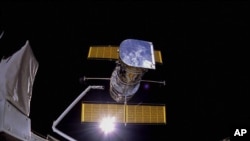Friday marks 30 years since the groundbreaking Hubble Telescope, the first optical telescope to be put into space, was sent into orbit.
The Hubble rocketed into orbit aboard space shuttle Discovery April 24, 1990 and was later deployed by the shuttle’s crew members.
The telescope, named for American astronomer Edwin Hubble, was created because astronomers at the U.S. space agency NASA wanted an observatory free of the Earth’s atmosphere and human-generated light.
But the initial excitement about Hubble quickly turned to disappointment when it was discovered the telescope's primary mirror had been manufactured incorrectly, blurring the telescope's optics.
Shuttle astronauts visited Hubble five times, from 1993 to 2009, to make improvements and repairs to the 13-meter-long observatory. The repairs paid off almost immediately, and since then, Hubble has made over 1.4 million observations and significant discoveries.
Among them, Hubble proved the existence of super-massive black holes and found they're located at the center of most galaxies. It also helped pinpoint the age of the universe at 13.8 billion years old, by determining the current rate of expansion of the universe with an uncertainty of just three percent.
Hubble's successor, the James Webb Space Telescope, was originally due to be launched in 2018, but has been delayed several times, and will now be launched no earlier than 2021.






